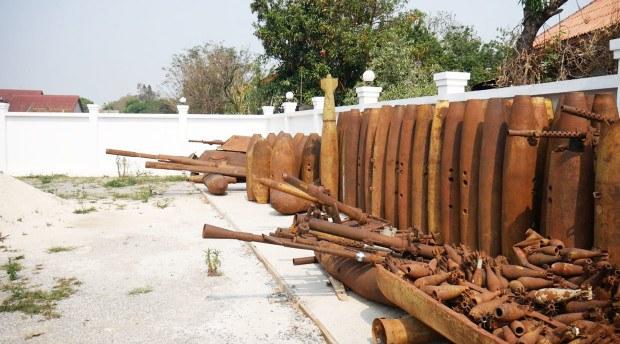
By Forrest Curran
Bombs were dropped on Laos every eight minutes, 24 hours a day, for nine years; or the equivalent of 1,000 pounds for every Laotian person. But very few know about this outside of Laos.
Today many of these bombs still sit active underground, known as unexploded ordinance (UXO): 30 percent of what was dropped on the country failed to detonate and is presently alive underground. This chilling legacy from the bombing campaign that lasted from 1964 through 1973 still prevents Laos from attaining self-sufficiency and has locked the country into a cycle of poverty.
Although Laos' economy is largely agriculturally based, as one of the most bombed countries in the world, this prevents the farmer-population from expanding their land for agricultural use in fear of consequences of the UXOs. There is clear under-utilization and lack of efficiency in the use of agricultural land due to the present situation that has forced Laos to be limited even in one of the most basic sectors of the economy. The lack of options forced Laos to create a dam in the Mekong River to create revenue from energy, and has thus become the center of international controversy of polluting a vital water source for neighboring countries.
Children who were born far after the bombings live through the consequences of the past, as the UXO situation of Laos not only prevents Laos from attaining economic prosperity and growth, but has also created a major safety hazard around the country. Forty percent of the total casualties related to UXOs involve children, often playing in a clearing of land before the ground blew up underneath them. The literacy rate is also very low, especially in the mountain villages, where accessibility to schools is limited due to the road conditions stemming from the UXOs. At the current rate of de-mining funding by the international community, it will still take another 800 years to fully clear the land of active UXOs.
MAG, a Noble Prize-winning de-mining NGO, has been largely the catalyst of change and de-mining in this country since the beginning. MAG trains, educates and organizes local de-mining teams to clear Laos of unexploded ordinance. MAG also forms all-women teams, which empowers Laotian women through a higher salary and allows them to gain status and respect in their villages. Many of the women work with pride in being able to support their families as well as serving to better the future of the country, where 40 percent of the de-mining teams in Phonsavan province are now all-women teams.
MAG has brought about astonishing change and improved the situation of the country, but it consistently faces concerns with the lack of international funding which is based from the lack of awareness by the international community.
In the village of Ban Napia, located in the mountains of the rural area of Phonsavan province, my social enterprise, Purple Buddha Project, is highlighting the issue in a new way: recycling aluminum remnants of war scrap to reconstruct an object that globally signifies negativity into jewelry and to create constructive change in Laos.
Upcycling plane parts, bullet shells and bombshell fins, each jewelry piece is embedded with actual pieces of history, where Purple Buddha Project looks to use the jewelry as discussion-starters and to spread awareness and knowledge of Laos. Each jewelry piece is created by an artisan employed by a local fair-trade cooperative, and the each purchase of jewelry contributes nine meals to schools that sponsor disadvantaged children of Southeast Asia to attend school free of cost. You can support the Purple Buddha Project here.
Image credits: Purple Buddha Project
Forrest Curran is Creative Director of Purple Buddha Project, a social enterprise that transforms weapons of conflict into jewelry. Purple Buddha Project currently works in Cambodia to transform gun bullets and bomb shells into jewelry pieces.
TriplePundit has published articles from over 1000 contributors. If you'd like to be a guest author, please get in touch!














